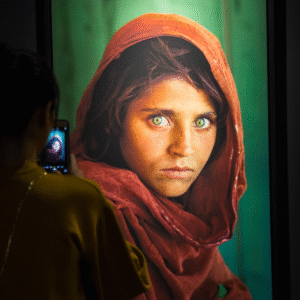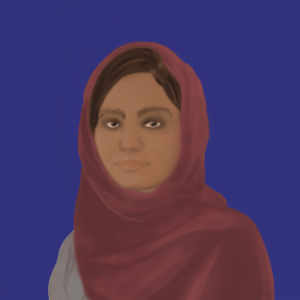18-year-old Sama from the Afghanistan Newsroom asks the Western media to treat Afghan girls as human beings

The famous National Geographic photograph of Sharbat Gula, known as the ‘Afghan Girl’.
Picture by: Imaginechina Limited | Alamy
Article link copied.
September 12, 2025
I’m a young Afghan, not a symbol

Every time the world turns its gaze to Afghanistan, I brace myself. Not because I’m afraid of being seen, but because I’m tired of being seen the wrong way.
As a young Afghan girl, I’ve watched my identity get flattened into a symbol: of sorrow, silence or survival. Our faces show up in fundraising campaigns. Our stories headline tragedies. But behind those images, the world rarely asks who we truly are.
Western media has long portrayed Afghan youth, especially girls, through a single lens, as passive victims. Veiled, voiceless, waiting to be saved. But we are not just surviving. We are speaking, creating, building. This narrow portrayal not only misrepresents us, it erases us.
Harbingers’ Weekly Brief
I’ve felt that erasure personally. In an interview about my love of writing and education for a Western website, I shared my dreams and ideas. But the published story ignored all that. It focused only on the “bravery” of studying under threat. I became a symbol of resilience – not a person with a voice.
That hurts more than silence. It tells us our suffering is more valuable than our hopes.
The example of Sharbat Gula
There’s a photo I still can’t forget: a girl my age, dusty-faced and wide-eyed, plastered across global headlines. No name. No story. Just another anonymous image of Afghan pain.
That girl was Sharbat Gula, the “Afghan Girl”, whose haunting, green-eyed gaze became one of the most famous photographs in the history of National Geographic magazine.
Yet behind that iconic image lies a complex truth. Sharbat Gula was a 12-year-old refugee in Pakistan when photographed in 1984, caught in a decade-long proxy war fuelled by Cold War politics that devastated Afghanistan. The article that introduced her to the world gave little context, euphemistically calling the brutal conflict “trouble” and painting the Afghan mujahideen, who violently opposed women’s freedoms, as “freedom fighters”.
Her image was stripped of personal history and framed through a Western Orientalist lens – one that romanticises and victimises Afghan women while justifying foreign interference.
Decades later, her story is still being used as a symbol. In 2021, after the Taliban’s return to power, Sharbat Gula asked to leave Afghanistan again. Italy’s government responded.
ABC News reported: “Italy has given safe haven to Sharbat Gula, the green-eyed ‘Afghan Girl’, whose 1985 photo in National Geographic magazine became a symbol of her country’s wars.… her arrival was part of a broader program to evacuate and integrate Afghan citizens.”
Once again, she became a face attached to geopolitical narratives – still recognised, still displaced. Sharbat’s photograph did not capture a girl with dreams or agency. Instead, it became a symbol, a powerful but incomplete representation shaped by political agendas and cultural stereotypes.
As Edward Saidtaught us, Orientalism turns real people into exotic “others”, passive and voiceless, existing only for the consumption of Western audiences. This legacy still influences how Afghan women’s stories are told – or left untold – today.
Now, under the Taliban’s puritanical rule, the erasure continues in new forms. In Kabul, women’s dress shop mannequinsare forced to wear plastic bags or aluminium foil over their heads. These hooded figures silently mirror the enforced invisibility of Afghan women themselves, caught between survival and suppression.
Yet, even amid oppression, Afghan women resist and create. Artists such as Shamsia Hassanireclaim public space with vibrant murals,reminding the world that Afghan women are more than symbols of suffering, they are agents of change.
The Western media’s fixation on Afghan women’s pain often serves political ends. Headlines about oppressive Taliban laws or threats of stoning are repeated without nuance, while the voices of Afghan women – poets, teachers, artists and activists – are too rarely heard.
We are not just symbols of tragedy. We are human beings with stories, hopes and strength. It is time for the world to see us fully and listen deeply – not through the narrow frames of victimhood or Orientalism, but with respect and solidarity.
We are not silent. You just have to start listening.
Written by:

Afghanistan
Contributor
LEARN Journalism Club
Illustration by Yuliia Muliar
Born in 2007, Sama is currently studying journalism through the joint project between Harbingers’ Magazine and LEARN Afghan.
Sama is interested in science and journalism, and enjoys sharing her knowledge with Harbingers’ audience. She dreams of one day being a businesswoman or a doctor, and wants to motivate other girls towards their dreams.
Sama speaks Dari and English.
Due to security concerns the author’s image and surname have been omitted
🌍 Join the World's Youngest Newsroom—Create a Free Account
Sign up to save your favourite articles, get personalised recommendations, and stay informed about stories that Gen Z worldwide actually care about. Plus, subscribe to our newsletter for the latest stories delivered straight to your inbox. 📲
© 2025 The Oxford School for the Future of Journalism


